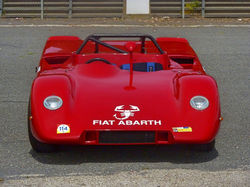
1971 Abarth 1300 SE 018 Biposto Cuneo

All photography work is copyrighted by the author, please don't download and publish these pictures in the internet without my permission!
Larger high quality pictures is available only for donators up on request! Vasileios Papaidis 2017 © All Rights Reserved
The 'Cuneo' or 'wedge'-shaped Abarth sports-prototype body design emerged in 1969 and was heavily influenced by the demonstrable aerodynamic performance of the Lotus Type 56 gas-turbine engined Indianapolis singe-seater Speedway cars of 1968. Design was by Abarth's long-faithful chief engineer Mario Colucci, a long-time advocate of central engine mounting ahead of the rear axle line in direct conflict with the philosophy of his boss, Carlo Abarth, who always preferred overhung outboard engine mounting, behind the rear axle.
It was at the end of February 1970 that Abarth of Turin launched its latest sports-racing car model, which was aimed primarily at new young drivers taking their first steps up from small-capacity touring car or kart-racing classes.
This was the Abarth SE018 otherwise known as the Fiat Abarth 1000 (or 1300) Biposto Corsa ('Racing Two-seater'). It was a very sleek, lightweight and handy little competition car and it would excel in National Italian events especially in the against-the-clock corsa in salita – hill-climb – series. Unlike its predecessor 1000SP model – the Abarth SE04 – the 018-series design carried the Fiat-derived 4-cylinder power unit in Carlo Abarth's preferred location – cantilevered at an inclined angle out behind the rear axle line.
Upon its public debut at the February, 1970, Racing Car Exhibition, the new 1000 Biposto Corsa took the centerpiece role in Abarth & C's display. In fact it looked so tiny between its sister pair of Abarth-modified touring cars – an Autobianchi A112 and a Fiat-Abarth 1000 Berlina – it was instantly nicknamed the Abarth 'Millino'.
Photo Gallery



























